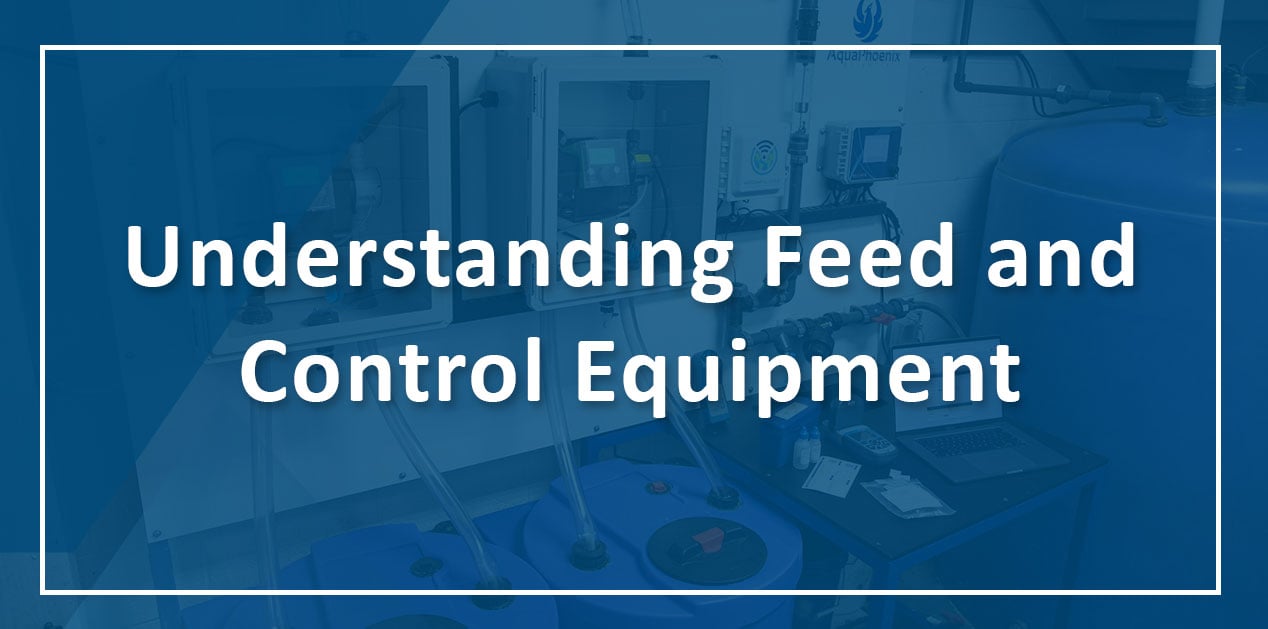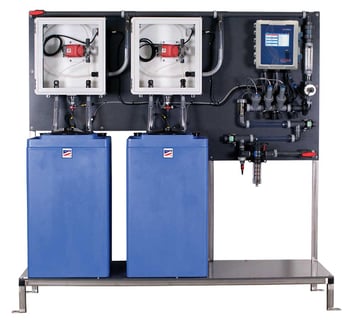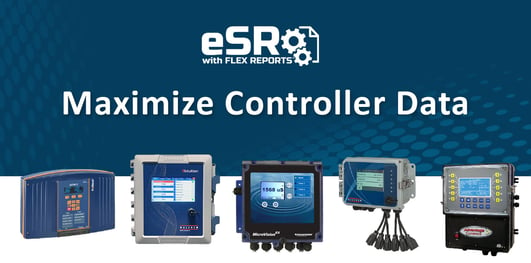
The chemical feed and control system is key to the success of a water treatment solution. Along with delivering the water treatment chemistry to the system, the feed and control equipment package also assumes the task of controlling and monitoring system parameters such as conductivity, pH, ORP, and more. A feed and control solution is comprised of controllers, sensors, pumps, valves, tanks, feeders, analyzers, and sometimes customer-provided system data.
All these work in concert to ensure that the water treatment solution is properly delivered, monitored, and controlled. As communication technology has evolved, electronic data management has become essential as well. Remote monitoring, data acquisition, and alarming have become commonplace in many chemical feed and control equipment packages.
How Do Chemical Feed and Control Systems Work?
The parts of a feed and control system can vary by the type of system being treated, but they all share very similar components. These include a controller, pumps and/or other chemical delivery apparatus, sensors, valves, and in some cases, bulk storage tanks.
In a typical chemical feed and control system, a controller or PLC monitors various system parameters and acts on these parameters based on settings (setpoints) that have been predetermined by the water treatment professional. These can include parameters such as conductivity, pH, ORP, tank level, chemical treatment levels, etc.

An example of parameter-based control is conductivity control. This control loop or algorithm is comprised of a conductivity sensor and a control valve. The setpoint is typically a “force lower” setpoint, meaning that as the conductivity rises past its setpoint, the system forces it lower by opening a valve to let the high conductivity water out, thus allowing lower conductivity makeup water to be added to the system. It’s important to note that the act of bleeding water from the system does not lower the conductivity; it’s the addition of the lower conductivity makeup water that accomplishes this.
Chemical addition can be accomplished using pumps, valves, eductors, erosion feeders, pot feeders, etc. The most common method for chemical addition is via metering pumps. The pump draws the water treatment chemical from either a drum, pail, or bulk container and “injects” it into the system. Metering pumps are precision instruments and can be activated using several methods:
- Sensor-based control
- Timer-based control
- Scenario-based control
An example of sensor-based control is the use of a fluorometer to control the addition of chemical to a system. This is a “force higher” feed method where a sensor, typically PTSA, monitors the level of product in a system by looking for PTSA that is present in the system as a tag or tracer that corresponds to the level of scale and corrosion inhibitor present in the system. When the level of PTSA falls below a setpoint, a metering pump is activated and delivers product that is tagged with PTSA to the system. Once the system recognizes that the PTSA level has come up into the desired control range, the pump turns off, and the system continues to monitor the PTSA level.
These are just a few of the many ways a chemical feed and control system works. Modern systems have a virtually limitless number of methods to ensure that the feed and control equipment meets the demands of the treated system.
The Benefits of Chemical Feed and Control Systems
In addition to the basic chemical feed and control role that equipment plays in the water treatment program, chemical feed and control systems offer several other benefits. These include the ability to control parameters based on system chemistry, operating conditions, and other system parameters that may be ignored without modern feed and control equipment.
Improve Dosing Accuracy
Dosing accuracy is improved by setpoint-based control vs. the past choice of timer-based control. With the addition of water meters and remote monitoring and/or local alarming, modern feed and control systems will alert personnel if a system uses an excessive amount of water. This simple solution can save a large amount of water and, therefore, money by detecting common issues such as a malfunctioning makeup valve. If undetected, even a small valve leak can lead to a substantial loss of water and chemicals from the treated system.
Maintain System Efficiency
Along with water loss, excessive water retention is also detrimental to system performance and can lead to fouling of the heat exchange surfaces. Systems are designed to function properly with the correct ratio of cycles of concentration and chemical levels. An increase in cycles of concentration due to a loss of ability to release water from the system can lead to scaling or fouling. Similarly, failing to add the proper amount of deposit control chemistry or biocides can lead to the same. The energy increases due to fouled heat exchange surfaces can be many times more costly than excessive water use.
Reduce Operating Costs
The financial and environmental payback of a quality feed and control system is difficult to overstate, as even a minor excursion can result in costly repairs, excessive energy use, overuse of water, and in some cases, safety issues. Properly configured feed and control equipment will ensure systems run at peak performance while bringing measurable ROI to your customer.
Types of Feed and Control Systems
There are many types of feed and control systems on the market. The following are the most commonly available.
Pre-packaged Water Treatment Controllers
Pre-packaged feed and control systems come pre-configured with industry-standard feed methods and are typically designed specifically for industrial water treatment. These systems are comprised of a base controller and sensors. The water treatment controllers in this setup will have a limited number of inputs and outputs, the number of which is generally sufficient for most water treatment programs. The controller manufacturer provides a line of sensors that have been designed to work with the base controller. This simplifies the operation since the calibration, configuration, and diagnostics are incorporated into the controller for these sensors. Along with these, most OEM water treatment control systems will allow for the addition of generic sensors. These include level sensors, fluorometers, analyzers, water meters, and a multitude of analog and/or digital sensors. The addition of these may necessitate additional boards (cards) in the base control system. A major benefit to these systems is the built-in programming and simplicity of configuration. This system can be configured and maintained by a water treatment professional or system operator and does not require any true programming.
PLC (Programmable Logic Controller) Systems
Occasionally the basic water treatment control systems may not be sufficient for an application. A specific customer requirement or control algorithm may not be available in a pre-packaged control system and must be custom programmed in a PLC system. PLC systems are comprised of a processor, input/output modules, and an HMI, or Human Machine Interface, used to interact with the PLC. These are commonly referred to as a touch screen or operator interface. PLCs can be costly due to the equipment cost and programming time associated with this type of system, however, the benefits of meeting a specific system need often offset these costs. These systems require true programming. Modifications to feed methods will most likely need to be performed by a programmer or systems integrator.
The Role of Controllers in Feed and Control Equipment
As the heart of the treatment program, the chemical feed and control system is key to its success. It not only monitors the system and delivers the product, but it also acts as the water treatment professionals’ eyes and ears. The feed and control equipment monitors system parameters 24 hours a day and can be invaluable as it can provide the data used to determine the cause of an unfortunate system failure. These control systems may also possess the ability to adjust chemical use.
Since most modern control systems now offer the ability to data log and, in many cases, push that data to the cloud, electronic data management and analysis has become commonplace amongst water treatment professionals. Online solutions like eSR with Flex Reports provide a centralized location to store controller data and allow you to compare the data with field-acquired data such as daily operator logs, service reports, corrosion data, microbiological data, etc.
When combined with cellular technologies, modern feed and control systems can be monitored and configured remotely. This gives the water treatment professional the ability to monitor critical systems and parameters between regular service visits that would historically require additional site visits. By using remote monitoring software and automated alarms, you can be notified of problems in real-time that would otherwise go undetected until the next regularly scheduled site visit.
Simplify your Equipment Set-up with AquaPhoenix Scientific
As an industry leader in feed and control technology, we can create a standardized chemical feed and control equipment package for you. When you design a system with AquaPhoenix, you get to choose from all the top brands. Our team will work with you to recommend and select the best equipment for your application.
By integrating these components into one of our custom panel and/or skid systems, you can deliver a true water-in, water-out control system that will greatly simplify the installation and maintenance of your feed and control equipment.
Connect with our team today to save time in the field and improve your service visits. Download our industrial catalog to browse thousands of products or request a quote to get started on your next job.



